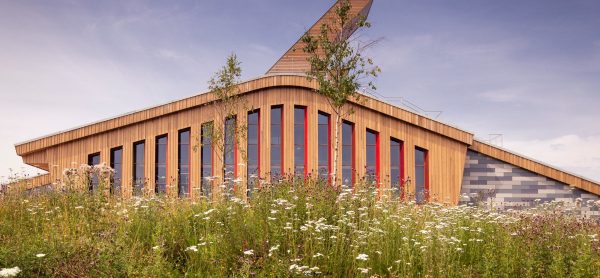How Sustainable Architecture Drives Cultural Transformation

In an era where climate change and resource depletion are front and centre in global discussions, sustainable architecture is no longer a niche concept—it has become a critical response to the environmental challenges we face, and a part of the UKs plan for its future. However, the impact of sustainable architecture goes beyond a building’s individual carbon footprint.
Architecture that embeds sustainability in every level of design plays a pivotal role in incentivising eco-conscious behaviours and driving broader cultural transformation. By integrating green practices into the design and operation of our buildings, we influence not only the built environment but also how communities think, behave, and interact with the planet.


Sustainability and Life Science
Life science buildings are usually, by nature, extremely unsustainable. These complex facilities require advanced systems for air handling, house energy-intensive equipment, and often produce harmful byproducts. Despite these challenges, sustainable design in this sector is not only possible, but also currently emerging all over the UK.
Highly innovative material and system designs are making massive leaps towards reducing the carbon footprint of these buildings. However, this is only one component of a buildings environmental impact over its lifetime. Often overlooked is a building’s ability to influence its occupants through visual and spatial cues. Done correctly, this relationship between building and occupant has the power to impact not only the sustainable operations of the building but contribute to a wider cultural change.
Life science buildings are more than just workspaces; they are hubs of innovation where some of the world’s most important research on health, pharmaceuticals, and biotechnology takes place. By embedding sustainability into the design of these facilities, we influence the next generation of scientific minds to prioritise eco-friendly practices both in the lab and beyond.


Case study: The GSK Centre for Sustainable Chemistry
The Centre for Sustainable Chemistry (CSC) was developed as a joint project between GSK and the University of Nottingham which continues to set sustainability benchmarks today. This LEED Platinum and BREEAM Outstanding facility uses a state-of-the-art materials, wind-based heating and cooling, and highly optimised systems to act as a carbon sink. The CSC exports a net average of 40MWH annually, and advanced modelling has returned that the building will achieve carbon neutrality in less than 30 years, all without hindering the scientific capabilities.
However, the building design does more than just pay back the planet in raw energy production. The evidence of sustainable ethos throughout the building, such as the exposed timber, exposed green roof, and embedded sustainable operation instructions, has fostered a culture of behavioural change amongst the occupants. These visual reminders have led to continuous efforts and conscious choices to minimise consumption and waste in the labs, which is bleeding out to broader organizational and industry practices.
“The cultural and behavioural impact of the building on the wider science community is undeniable”

Change Spreads
Many studies have shown that promotion of an environmentally responsible culture at work has a direct relationship to the increase of employee’s pro-environmental behaviours, or “PEBs” as they are often referred to in research. One study even shows that the promotion of sustainability in the workplace accounted for 36% of the variance in people’s voluntary PEBs.
The community at the CSC, which benefits from both a strong visual representation of sustainability as well as a strong commitment to sustainable operation from the managerial team, is seeing similar effects as those demonstrated in research. Leadership has reported that researchers are voluntarily making more mindful choices in the lab like reducing chemical waste, reusing materials, or choosing energy-efficient equipment cycles. Research also tells us that this behaviour doesn’t stop when they walk out the door.
Eco-awareness at work has consistently demonstrated a causal relationship with a person’s willingness to be sustainable at home and in their daily lives. It has also demonstrated an interesting correlation to organisation pride, suggesting that climate consciousness at work boosts a person’s sense of pride in their company, which benefits the organisations retention of employees and contributes positively to their wellbeing.
With effects like these, designing buildings that in themselves promote sustainability and a connection to the natural world is a not only a benefit to the planet, but also to the culture of a workplace and the wellbeing of its employees. It is this kind of relationship between people and buildings that will drive long-term change, and broader cultural transformation.
The positive effects of sustainable architecture are not only felt by those who occupy these buildings. Buildings certified through programs like LEED (Leadership in Energy and Environmental Design) or BREEAM (Building Research Establishment Environmental Assessment Method) often serve as educational tools, showcasing innovations in sustainable design to the world.
Within the context of Life Science, it is especially powerful to send a message that groundbreaking scientific discovery can happen within environmentally responsible environments, and to act as role-models for the future of this traditionally resource-heavy sector.
Features such as rainwater harvesting systems, solar panels, and natural building materials communicate a strong message to occupants, visitors, and viewers: sustainability is achievable, practical, and integral to modern living. These visual and functional cues being present in people’s environment invite people to rethink their relationship with the planet.

As we look to the future, the role of sustainable architecture in shaping a culture of eco-consciousness will only grow more significant. Architects, urban planners, and policymakers must continue to push the boundaries of what is possible, sharing a duty to remain at the forefront of sustainable technology and building practices.
In the end, the buildings we design today are more than structures—they are statements about our values, our priorities, and our vision for the future. Sustainable architecture is not just about reducing energy use or minimizing waste; it is about creating a world where environmental responsibility is ingrained in our culture and our way of life. Through thoughtful, innovative design, we have the power to build not just sustainable buildings but a sustainable future.

